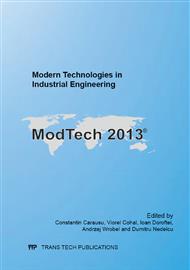[1]
D. Krenczyk, K. Kalinowski, C. Grabowik, Integration of production planning and scheduling systems for determination of transitional phases in repetitive production. Lecture Notes in Computer Science (including subseries Lecture Notes in Artificial Intelligence and Lecture Notes in Bioinformatics), 7209 LNAI (PART 2), (2012).
DOI: 10.1007/978-3-642-28931-6_27
Google Scholar
[2]
H.C. Zhang, D. Zhang, Integration of process planning and production scheduling: overview, analysis and object-oriented modeling. Integrated Product, Process and Enterprise Design. Manufacturing Systems Engineering Series vol. 2 (1997).
DOI: 10.1007/978-1-4615-6383-9_12
Google Scholar
[3]
A. Dymarek, T. Dzitkowski, Method of active synthesis of discrete fixed mechanical systems. Journal of Vibroengineering 14 (2) 2012, pp.458-463.
Google Scholar
[4]
C. Grabowik, D. Krenczyk, K. Kalinowski, The hybrid method of knowledge representation in a CAPP knowledge based system. Lecture Notes in Computer Science (including subseries Lecture Notes in Artificial Intelligence and Lecture Notes in Bioinformatics), 7209 LNAI (PART 2), (2012).
DOI: 10.1007/978-3-642-28931-6_28
Google Scholar
[5]
G. Ćwikła, Automatic data acquisition from production systems for management support systems (in Polish). Selected Engineering Problems, vol. 2 (2011), pp.79-84.
Google Scholar
[6]
K. Kalinowski, D. Krenczyk, C. Grabowik, Predictive-reactive strategy for real time scheduling of manufacturing systems. Applied Mechanics and Materials, 307 (2013), pp.470-473.
DOI: 10.4028/www.scientific.net/amm.307.470
Google Scholar
[7]
J. Świder, M. Hetmańczyk, P. Michalski, Utilization of advanced self-diagnostic functions implemented in frequency inverters for the purpose of the computer-aided identification of operating conditions. Journal of Vibroengineering, 14 (1) (2012).
Google Scholar
[8]
I. Paprocka, D. Urbanek, A numerical example of total production maintenance and robust scheduling application for a production system efficiency increasing. Journal of Machine Engineering, Vol. 12. No. 3. Heuristic Methods of project and production scheduling, Poland, (2012).
Google Scholar
[9]
C. Grabowik, K. Kalinowski, Object-oriented models in an integration of CAD/CAPP/CAP systems. Lecture Notes in Computer Science (including subseries Lecture Notes in Artificial Intelligence and Lecture Notes in Bioinformatics), 6679 LNAI (PART 2), (2011).
DOI: 10.1007/978-3-642-21222-2_49
Google Scholar
[10]
S.N. Pillutla, B.N. Nag, Object-oriented model construction in production scheduling decisions. Decision Support Systems, vol. 18 (1996), pp.357-375.
DOI: 10.1016/s0167-9236(96)80010-8
Google Scholar
[11]
Ch. Chandra, Supply Chain Workflow Modeling Using Ontologies. Collaborative Engineering, 2008, pp.61-87.
DOI: 10.1007/978-0-387-47321-5_4
Google Scholar
[12]
http: /www. uml. org/ [02. 07. 2013].
Google Scholar
[13]
T. Tsai, R. Sato, A UML model of agile production planning and control system, Computers in Industry, vol. 53 (2004), pp.133-152.
DOI: 10.1016/j.compind.2003.07.003
Google Scholar
[14]
M. Valiente, G. Genova, J. Carretero, UML 2. 0 Notation for Modeling Real-Time Task Scheduling, in Journal of Object Technology, vol. 5, no 4, May-June 2005, pp.91-105.
DOI: 10.5381/jot.2006.5.4.a2
Google Scholar
[15]
K. Kalinowski: The scheduling of discrete production processes (in Polish). Wydawnictwo Politechniki Śląskiej, Gliwice (2013).
Google Scholar


